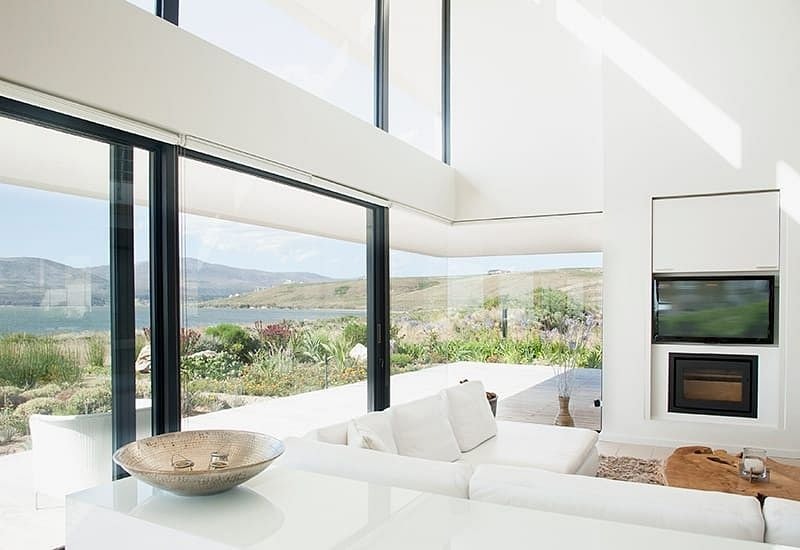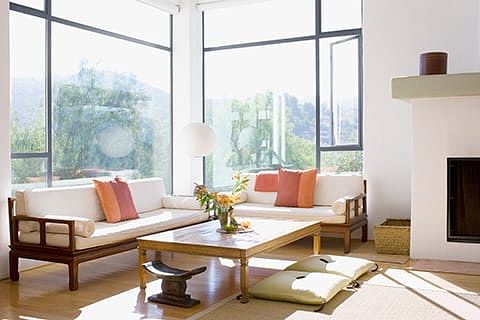Go Natural in Your Home Lighting Design
Posted
on December 4, 2017

The use and impact of light is an afterthought element in too many homes. The good news is with just a few small changes you can create a significant improvement in your home’s atmosphere and energy bills.
Start with Natural Light

Natural light has gotten a lot of attention as of late for two main reasons: it’s free, and it can have positive effects on people’s mood and mental health.
Low-E is Key
To capitalize on natural light, windows should be high efficiency and low emissivity, commonly known as Low-E. Daylight has three main components:
- Ultraviolet light which can damage your skin and fade your upholstery
- Infrared light is what carries the majority of the heat in sunlight. That’s why sunny rooms in old houses are usually warmer.
- Visible light is just what it sounds like, the light that illuminates things, and also carries some of the heat of the sun.
Low-E windows let a good portion of visible light in while keeping most of the ultraviolet and infrared light out.
Reduced energy bills
Lighting accounts for approximately 5% to 10% of total energy use in the average American home, costing the typical household between $75 and $250 per year in electricity.1 Sunlight is free, and if you use it wisely you can reduce electricity use for lighting. Those simple truths have spawned a subset of architecture and design focused on capitalizing on natural lighting in ways that reduce energy consumption.
Capitalize on natural light
Placing windows in the right places or orienting the house correctly if you are building from scratch can make an amazing difference in how much natural light comes into your home. Also, replacing old windows with Low-E windows — especially on sides of your home that get lots of sun — and even orienting houses in a certain way can help homeowners see energy reduction.
In general, south-facing walls offer the most opportunity to let natural light in, while north-facing walls provide the least.
Once you open the shades, you can help sunlight bounce around the room by using lighter paint and flooring. Strategically placed mirrors are also an easy way to ramp up the impact of sunlight.
Another growing trend is known as daylight harvesting, also known as sunlight harvesting. The term simply means making the best possible use of daylight in your home. The movement has spawned ingenious ideas like reflective louvers and precisely placed mirrors that direct far more sun into the room. Daylight harvesting also uses technology like optical sensors that adjust the level of electrical light as the amount of natural light changes throughout the day. There are also even exotic things like sun tunnels and solar tubes that are similar to skylights but use many small reflective surfaces to greatly intensify the sunlight to the point that it looks like an overhead light. Solar tubes are gaining popularity in commercial settings such as factories that have abundant roof space.2
Boost your mental health
Provided you don’t overdo sun exposure, getting some rays has many positive effects on humans. Most people have heard of Seasonal Affective Disorder (SAD), a condition where a lack of sunlight leads to depression. According to healthline.com there are many other positives that come from responsible exposure to sunlight including building healthy bones, preventing some kinds of cancer and healing some skin conditions.3
Types of Light in a Light Plan
All of these types of light can come from either natural sources or artificial (electric) light.
Ambient light is the overall illumination of an area and not focused on any one area. Ideas like using light paint colors and flooring, installing Low-E windows and keeping them clean to strategic placement of mirrors and other reflective surfaces are examples of using sunlight as ambient light.
Task light is light that is intended to illuminate a specific task. An example is lights over a kitchen island, on a workbench, or by a reading chair.
Accent light is decorative light, used to call attention to objects or areas. Track lighting is a good example of accent lighting, as is using colored light in landscaping. Contemporary architecture sometimes uses strategically placed windows to create accents or light patterns designed to be part of the aesthetic of the room.
Making Your Lighting Plan
Any time you renovate, you should figure lighting into your plans. Renovations allow for changing fixtures, paint colors, even window position and shapes to improve lighting, enjoy more mood-enhancing natural light and reduce energy costs. But changing lighting doesn’t require major renovation. With a vast array of lighting products on the market, you can give your home a lighting makeover relatively easily.
When approaching an existing room, consider these home lighting ideas:
- What is the general use of this room? What atmosphere are you going for? Soothing and relaxing? Bright and cheery? Comfortable for conversation? How much ambient light is needed for that use?
- Are any tasks performed in this room? If so, what light is needed for them? Some rooms, like family rooms where many different activities happen, will need more flexible lighting than others.
- Is there anything in this room you’d like to emphasize — such as a fireplace, architectural feature, wall texture or artwork — or any creative way you can use light?
- What is your personal preference for light? Warm glow, bright white, incandescent, minimal?
Once you have the primary use and goals for the room identified, the first question should be “how can I best use natural light in this room?” The answer may be as easy as new, lighter paint and flooring or replacing heavy dark blinds with lighter, more reflective options. You can also get creative with mirrors to bounce light around. Move your task areas closer to windows to capitalize on abundant natural light if possible. Even changing habits like opening drapes and blinds before turning on lights can help more sunlight shine in.
1http://smarterhouse.org/appliances-energy/lighting
2https://www.lavancha.in/tubular-daylight-basics/
3https://www.healthline.com/health/depression/benefits-sunlight#benefits3
Schedule a free consultation to find windows and doors for your home.
